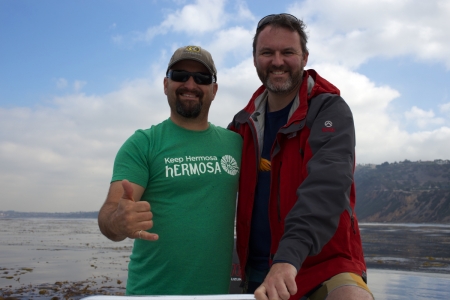If you’ve enjoyed a day at Southern California beaches over the past 10 years, now is a good time to take a moment to thank Kirsten James.
Kirsten has been Heal the Bay’s lead watchdog for clean water for nearly a decade, most recently serving as our co-Science and Policy Director. During her tenure, beach water quality has steadily improved, with 93% of L.A. County beaches now getting A or B grades. And while she may cite the drought and less runoff for the cleaner waters, Kirsten and her team can take a lot of the credit.
Kirsten has now decided to take the next step in her professional career by exiting Heal the Bay to join the Boston-based nonprofit Ceres. She will develop a West Coast water program for the group, which catalyzes major industries to invest in sustainable practices.
Her years in the trenches of Southern California water policy will serve her new group well. Kirsten stands strong to protect the federal Clean Water Act locally in the face of many challenges. She has played a pivotal role in ensuring that water quality standards are met in the region’s various water bodies and that dischargers are held accountable when they pollute our creeks, rivers and ocean.
It’s tedious and repetitive work at times — testifying at dozens of Regional Water Quality Control Board meetings held in stuffy conference rooms, poring over inches-thick technical permits written in legalese, and negotiating patiently with harried bureaucrats, skeptical dischargers, and fellow non-profits.
It takes a unique blend of personality and knowledge to be an effective advocate. I think that Kirsten’s success has been built on a bedrock of traditional Midwestern values. As a native Missourian, she’s industrious, self-effacing and unfailingly polite. Think of her as the Girl Next Door – but with an encyclopedic grasp of arcane water quality regulations and a dogged determination to see them enforced.
When our longtime president Mark Gold transitioned to UCLA three years ago, Kirsten had huge shoes to fill in taking over Heal the Bay’s water portfolio. After years of apprenticing under the famed environmental warrior, she now was calling the shots on water strategy and policy. Slowly but surely, she found her own voice and style, leading us to some remarkable wins. Among her most recent accomplishments:
- Securing the adoption of a more holistic MS4 stormwater permit for the greater L.A. region, which requires municipalities to treat water as a resource to be reused and recycled.
- Playing a lead role in drafting and implementing plastic bag bans in the city and county of Los Angeles, which served as model for the recently enacted statewide ban.
- Leading the legislative charge in Sacramento to reform Prop 218, making it easier for cities to secure public funding for multi-benefit water projects.
The Bay is healthier than it was a decade ago, thanks to Kirsten. As are the swimmers who recreate in it. As the modest Kirsten attests, still waters run deep. Very deep.







 Hartley, right, exploring PV Peninsula with our senior aquarist Jose Bacallao
Hartley, right, exploring PV Peninsula with our senior aquarist Jose Bacallao